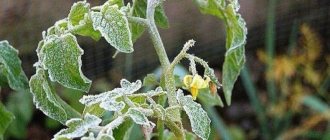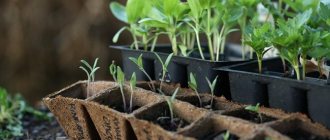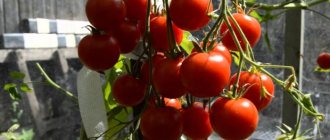Several years ago, seedling snails and diapers became a real discovery among domestic gardeners. What are the pros and cons of this technology and how to properly grow seedlings in snails and diapers?
Every spring, agriculture enthusiasts clutter their apartments with boxes of seedlings. They occupy window sills, shelving and all available horizontal surfaces, require endless watering and often, with the help of children and pets, end up on the floor. Proponents of the modern method of planting seeds in snails have solved most of these problems, but have acquired a couple of others in return.
Features of picking in diapers
Diapers are soil wrapped in plastic film where tomato seeds are planted. This method has a number of features:
- Dense polyethylene is used to cover greenhouses and greenhouses.
- Prepare a special container for placing seedlings in diapers. It is selected in large sizes with high sides.
- Cover the bottom with sawdust.
- The film should not be rolled tightly to allow air to enter, otherwise the seeds will not germinate.
General provisions
Reference. A diaper is a small bundle of fabric (usually a paper towel or toilet paper) and plastic film (plastic bag, stationery file, notebook cover, etc.), into which seeds are sown and seedlings are planted.
The germination rate of seeds with this sowing method is quite high. This is explained by the fact that they find themselves in an ideal environment for germination and growth: high humidity, maintained by constantly moistening the paper, and the temperature rising inside the plastic wrap, together create a “greenhouse effect” that has a beneficial effect on the development of the future plant.
Advantages and disadvantages of the method
Each method has its own advantages and disadvantages.
Benefits include:
- convenient procedure;
- less soil is used;
- boarding diapers can be used several times;
- protection of seedling material from diseases and pests;
- seedlings wrapped in diapers are easier to transport;
- space saving.
The disadvantages include:
- the root system develops slowly compared to ordinary seedlings;
- seedlings do not have enough light;
- with intensive growth, it becomes necessary to plant in separate containers.
How to plant tomatoes in a diaper?
There are several ways to plant:
- with soil: sow seeds or plant sprouted sprouts;
- without primer: using toilet paper.
Pre-sprouted seeds
Cultivation can be done with seeds that have sprouted in advance. Such seeds can be sown in prepared diaper material.
Sequence of stages:
- Cut a piece of polyethylene the size of a notebook sheet and place it on a flat surface;
- Place nutritious soil, pre-moistened, on the corner;
- Place a sprout of sprouted seed on it, the leaves are located above the level of the film;
- add the same amount of soil;
- roll up, holding the tender sprout carefully;
- so that the polyethylene does not open, fasten it with thread or a loose elastic band;
- place in a container;
- place the container in a well-lit place;
- To create a suitable microclimate, cover with a film with cut holes.
Seedlings in Moscow
Planting seeds this way is easy. No soil is used with this method. The paper is saturated with water and the seeds germinate. To do this you need:
- cut strips about 10-12 cm wide, no more than 0.4-0.5 m long (the length depends on the number of seeds);
- for seeds of each variety you need to make separate strips;
- prepare plastic glasses, label the varieties for convenience and the sowing date;
- spread the film, place toilet paper on top;
- irrigate with water;
- retreat 10 mm from the edge, lay out a row of seeds;
- inter-seed distance 2 cm;
- cover the top with a layer of paper and sprinkle;
- cover with a strip of film;
- twist, secure with an elastic band and place in a prepared plastic cup;
- pour water from the bottom edge of the paper to a level of 2 cm;
- place the cups in a container, cover with film with holes to create a microclimate;
- put in a warm place;
- periodically change the water;
- seedlings need to be fed with fertilizers based on humic acids with a concentration half as much as specified in the instructions.
See also
Choosing a tomato variety for growing on a windowsill, sowing and care rules for beginners
Read
Sow into snails with substrate
Germination of seedlings is carried out by sowing seeds directly into film. Stages of work:
- cut polyethylene into strips 0.1 m wide;
- lay a thin layer of toilet paper on it;
- moisten with aloe solution (juice) using a spray bottle;
- sprinkle with earth;
- spread the seeds, keeping a distance of 3-4 cm, or germinated seedlings;
- sprinkle with earth, irrigate;
- cover with paper and film;
- roll up, place in plastic glasses with water;
- place the glasses in containers, make a film covering, and place them in a warm place;
- After germination, remove the coating;
- Separate it together with the paper and plant it in the soil.
In this way, seedlings adapt easily and well, since the root system remains intact. Seedlings develop faster, overtaking seedlings harvested using the usual method. Such seedlings survive until planted in the ground.
Seed preparation
- Disinfection .
Most infectious diseases of tomatoes are transmitted through soil, containers and seed. Since the method of germinating seeds in a diaper does not require either a large quantity of substrate or a container, the issue of disinfecting the seed material comes to the fore. For these purposes, the seeds can be immersed for 20 minutes in a 1% solution of potassium permanganate (1 gram per 100 ml of water) or for 8 minutes in a 2–3% solution of hydrogen peroxide, heated to +40C. - Treatment . After disinfection, it is recommended to immerse the seeds in a nutrient solution of a growth stimulator to ensure a higher percentage of germination: you can use both purchased preparations (Epin, Zircon, Heteroauxin, etc.) and prepared yourself (aloe juice solution (1:1) or honey water (1 tsp per glass of water).
- Soaking . Experienced gardeners also recommend soaking the seeds for 12 hours in warm water (+25C) before sowing, which must be changed every 4 hours.
- Germination. And for one of the methods, which will be discussed below, you will need already sprouted seeds. For these purposes, you need to prepare a saucer, cloth, gauze or paper towel.
Moisten the fabric, place it flat on a saucer, pour tomato seeds of the same variety onto it and spread over the surface, cover the container with a plastic lid or plastic bag and place in a warm place (+23C - +25C) for 3 - 5 days.Important. All this time, it is necessary to ensure that the fabric is constantly kept wet, otherwise the seeds will simply dry out.
Care
Like all plants, sprouts in diapers require care. After picking you need to:
- While the seedling material is under the film, it needs to be ventilated. To do this, it must be open every day for several minutes. In this way, the sprouts are hardened.
- Watering should be done moderately so that the liquid does not stagnate in the rolls.
- Fertilize the seedlings twice a week, reducing the usual dose by 2 times. Tomatoes love banana peel infusion.
- If there is insufficient lighting, use a fluorescent lamp.
- Regularly remove condensation from the film to prevent mold from appearing.
- When 4-5 sheets appear, unfold the film, add soil and roll it up again.
See also
Description of the best varieties of tall tomatoes for open ground
Read
Using already germinated seed
How to plant tomatoes using germinated seeds:
Prepare everything you need: plastic film, rubber band, substrate (any composition suitable for growing tomatoes), sprouted seeds, container, scissors, spray bottle.- Rectangles are cut out of the film, the size of which is close to the size of a school notebook.
- Place 1 tbsp in the upper left corner of the prepared rectangle. moistened substrate.
- A germinated seed is placed on top of the substrate so that its cotyledon leaves are above the film.
- For the sprout – 1 more tbsp. substrate, which is also moistened from a spray bottle.
- The bottom edge of the film must be folded and the entire rectangle rolled into a roll. The twist should be free to ensure unhindered access of oxygen to the roots.
- The resulting package is secured with an elastic band and placed in a container. All packages in the container are located close to each other.
- The top of the container can be covered with a transparent plastic film, in which holes are made for air circulation.
- The container with the sprouts is placed in a well-lit and warm place.
How to place in the ground
You need to pick again if the plants become crowded and begin to stretch upward. Roll out the roll, separate the sprouts from the diaper, and plant them in separate containers. To stimulate the development of the root system, pinch the central root trunk.
No matter how convenient the method is, tomatoes live in film more closely than in separate containers. Therefore, it is necessary to transplant it to a permanent place as quickly as possible. When planted in a greenhouse, the plant does not receive severe stress.
When planting in open beds, seedlings must be protected from temperature drops. If there is a threat of frost, it is necessary to cover the bed with film or plastic bottles.
Ways to grow seedlings at home
Most of the vegetable and flower crops in central Russia are grown by seedlings. In an apartment it is quite difficult to create optimal conditions, especially for a large number of plants. That is why gardeners are in great demand for new ways to grow seedlings in diapers and snails at home. These methods will reduce labor costs when growing seedlings, reduce the area occupied by containers with seedlings, and all this without compromising the quality of the grown plants.
Authors of the snail method
Recently, methods of growing seedlings in diapers and snails have become very popular. The idea of growing seedlings in rolls is not new; it was developed many years ago by the Soviet agronomist Kerimov. In honor of him, it was named “planting seeds in a roll - Kerimov’s method . And the method of growing seedlings in diapers has long been successfully used by the famous amateur gardener Kizima Galina Aleksandrovna , which she talks about in detail in her books. Yulia Minyaeva became the popularizer of this method on the Internet . ( Note, historical information: In fact, this is agronomist Kaziev Kerim Vadulovich , born in 1900, a native of Azerbaijan. He was convicted by denunciation, served a sentence in Solovki. In Solovki, he was engaged in the acclimatization of fodder crops in the Arctic, increasing productivity in harsh conditions. ) We need to remember the authors, and not just the popularizers. And Yulia Minyaeva , by the way, has worked very well on the technology for making snails at home using modern materials. This is also very important: not just knowing what to do , but also how to do it in the best way.
Benefits of snail seedlings
As a rule, growing seedlings in diapers and snails gives excellent results. The seedlings are strong and the root system is well formed. Such seedlings quickly take root when planted on the site, suffer little illness, and produce a good harvest. But, according to reviews, not all gardeners are able to use these methods. In this case, you need to properly understand the technology of growing seedlings in diapers and snails, taking into account all the nuances and subtleties.











